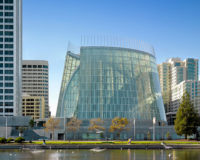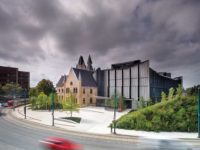Aqua
Studio Gang sets new heights for the Chicago skyscraper.

The 82-story tower overlooks Harbor Park, the center of the Lakeshore East development.
Photo © Jane Smith

Aqua’s swerving cantilevered concrete balconies allow panoramic views of Lake Michigan and surrounding landmarks.
Photo © Jane Smith

The 82-story tower sits on a three-story podium containing retail, apartment and hotel lobbies, and public spaces.
Photo © Jane Smith

Views from the cantilevered balconies include Millennium Park and the Art Institute of Chicago.
Photo © Jane Smith

Atop the podium is a roof garden where paths echo the serpentine lines of the balconies above.
Photo © Jane Smith

The luxuriously Modern residential lobby off Upper Columbus Drive reflects the design input of Loewenberg as well as Studio Gang.
Photo © Eric Hausman

Studio Gang’s model town house, shown in a rendering, occupies the lower portion of the podium, facing Harbor Park.
Photo © Jane Smith

Photo © Jane Smith

Image courtesy Studio Gang

Image courtesy Studio Gang

Image courtesy Studio Gang

Image courtesy Studio Gang

Image courtesy Studio Gang













Architects & Firms
Chicago, Illinois
Chicago’s skyscrapers may be famous for their technical achievements and functional expression, but they are often short on pizzazz. Now, Studio Gang has designed Aqua—a Niemeyeresque apartment and hotel tower whose architectonic facade of sensuously swerving, white concrete balconies jumps out from among its stolid brethren. Enabled by client Jim Loewenberg of the Magellan Development Group, Jeanne Gang, principal of Studio Gang, conceived the 82-story tower on a podium as part Loewenberg’s Lakeshore East, a 28-acre mixed-used development on the former Illinois Central Railroad yards edging Lake Michigan.
In addition to the water views on the east, this soigné antidote to Chicago’s straitlaced Modernism looks south to Millennium Park and the Art Institute of Chicago and north to the Chicago River, with the Hancock Center in the distance. Along the river, Aqua’s curvilinear architectural precursor—the cylindrical twin towers of Bertrand Goldberg’s Marina City (1964)—can be glimpsed from many balconies. While Goldberg’s scheme integrates the plan with the envelope, wedge-shaped rooms came with the price of admission. Since not all prospective occupants enjoy fitting furniture into irregularly shaped spaces, Gang’s decision to wrap a rippling carapace around a rectilinear poured-in-place concrete frame at Aqua makes sense in terms of construction and marketing. For her part, Gang contends that the building’s orthogonal core reflects Chicago’s grid.
Naturally, the question arises about how a female architect with a 37-person firm, known for smaller-scale community centers and houses, got to design a 1.9- million-square-foot tower, which cost $300 million in construction. Loewenberg, an MIT-trained architect as well as developer, met Gang at a dinner in Chicago following a lecture by Frank Gehry. Since Loewenberg had already enlisted the usual ranking Chicago architects to design portions of his development, including Skidmore, Owings & Merrill as master planners, he claims he was ready for a “young architect who had not done a high-rise before.” Gang, trained at the University of Illinois, Harvard’s Graduate School of Design, and Eidgenössische Technische Hochschule (ETH) in Zurich, offered the proper pragmatic sensibility. Loewenberg wasn’t worried about Gang’s high-rise experience: He would be the executive architect as well as the client.
The 180,000-square-foot site on the western edge of Lakeshore East generated a tower-on-a-podium solution that would negotiate the 50-foot drop in grade between Upper Columbus Drive on the west and Harbor Park at the center of the complex on the east. The podium itself contains lobbies for both the hotel (a hotelier is to be designated this month) and the apartments, along with retail stores, a ballroom, an indoor pool, and other public spaces. Beneath all that is a parking garage. Above, the tower is divided into the hotel, on floors 4 to 18; 474 rental apartments, on floors 19 to 52; and 264 condos on the floors above. Atop the tower are penthouses, on the 80th and 81st floors, where ceilings go as high as 14 feet.
In designing the balconies that extend outward from 2 to 12 feet, Gang thought of them as a concrete topography that would remind Chicagoans of limestone outcroppings along the Great Lakes—only in this case, the rises and falls would extend vertically from the top to the bottom of the shaft. Here, too, the ledges—9-inch-thick concrete balconies—thin out toward the edge of the cantilever to help drainage. In working out the balcony contours, Gang conducted view studies of unimpeded sight lines for places of interest. The different ripples also allow oblique views up and down the facade from the various balconies. Moving between physical models and digital ones—switching from hand to computer—Gang’s team arrived at separate calculations for each floor plate.
Magellan found a way to be efficient about creating curves for the concrete balconies: An edge-form steel plate guided the pour and, when finished, snapped back into a straight plane to be reused and bent into another curve. While this method saved on construction, the team did not include thermal breaks between the outdoor and indoor slabs, owing to the complexity of the cantilevers. The absence has received criticism for the loss of heat during the winter due to the radiator effect. (For more on this debate, see GreenSource, Letters, March–April 2010, page 14, and Editors’ Letter, page 13). In response, Gang says that while thermal breaks would have been preferred, other considerations have saved energy, such as using Chicago’s District Energy System, along with the apartments’ natural ventilation, sun shading during the summer, and the use of high-performance glass to cut solar loads.
The architects wanted to make sure apartments could receive sufficient direct light and so created “ponds” of glass that interrupt the balconies in certain portions of the facade. To reduce the solar loads, they specified six types of glazing, including tinted, reflective, and fritted, along with low-E glass. The fritted glass also doubles as a safety factor in keeping birds from crashing into the tower—a strategy that won Aqua an award from People for the Ethical Treatment of Animals.
One of the most compelling features—besides the balconies—is the landscaped roof, 80,000 square feet in size, atop the 3-story podium. Working with Wolff Landscape Architecture, Studio Gang created a swirling garden with paths reminiscent of Roberto Burle-Marxe and planted with colorful flora in light soil. A sustainable by-product of the garden is the mitigation of the summer heat-island effect so typical of asphalt roofs. In addition, it provides occupants with other amenities—such as a running track, outdoor pool, and outdoor fireplace.
Although the rectangular podium itself is stark and blocky in comparison with the garden and tower, Gang softened the effect with two large concrete staircases that link the upper street level with the lower Harbor Park: One is a switchback stair, the other a spiral. On the east face of the podium, Gang inserted nine town houses, for which she designed interior finishes. She also executed finishes as well as furnishings for a model town house nearing completion.
Rectilinear floor plans and a squared podium are pro forma. What advances architecture at Aqua is the inventiveness of its swerving tiers of concrete, which not only heighten the tower’s livability for the occupants, but add to the appearance of the cityscape for Chicagoans. Yet the optical play is not without drawbacks: The visual appeal of Aqua’s curves works best close-up or at mid-distance, and on a bright, sunny day when the gleaming glass adds luster to the sinuous balconies. However, from a distance, and on a gray day, the curves flatten into straight lines, the white concrete darkens, and the ponds of glass turn into irregular swaths of patchwork. As an optical experiment—as a machine for viewing (looking at the city from the tower, and at the tower from the city)—Aqua is enchanting, but needs further research.
PeopleArchitect Studio Gang Architects Design Team: Owner/Developer: Architect of Record: Contractor: Shawn Rinkus, Colby Egan, Les Fitzpatrick, and Bob Rowan, superintendents; Geoff Vrba and Domenica Jimenez (tenant upgrades), project coordinators; Ryan Keane, concrete project manager; Steve Krebsbach, assistant concrete project manager; Sam Sampson, concrete superintendent; Jeff Hall, steel superintendent; Virginia Kobart, Maria Drozd and Michelle Cacagno, safety managers; and Tom Kruszewski and Doug Brunius, project engineers. Structural Engineer: Civil Engineer: Commissioning agent: Mechanical Engineer: Energy Consultant: Electrical Engineer: Lighting Consultant: Plumbing Engineer: Fire Protection Engineer: Landscape Architect: Foundation Contractor: Geotechnical consultant: Photography
|
ProductsStructural system: Concrete: Exterior cladding Brick block Metal/glass curtainwall: Glass; Park-homes Jeld-Wen, installed by Stock Supply Windows Panels on exterior of hotel composed of recycled paper content and phoenolic resin (Trespa) installed by Sobotec Plaster: Precast planters: Metal Railings: Windows, Glazing Silicons Doors Garage doors Roofing Recycled plastic lumber was used for decks (Trex) Custom Roof Garden System: with Hydrodrain 300 Filter Fabric; Hydroflex 30 Synthetic fiber reinforcement and root Barrier (Root Stop HD) Concrete Waterproofing Products: Modac, and Vulkem 350 by Tremco Interior finishes Special surfacing: Floor and wall tile: Furnishings Conveyance Lighting -Use of fixtures with light pollution control below 10% up-light. (US Architectural BSA6) at sidewalks/walkways and bollards in front of ballroom Controls: Chillers Plumbing Window washing equipment by Tractel Two non-for profit I-GO Car Stations in tower’s garage (I-GO) Car charging station that will accommodate up to 24 vehicles (Coulomb Technologies ChargePoint Network) Other key participants |



















